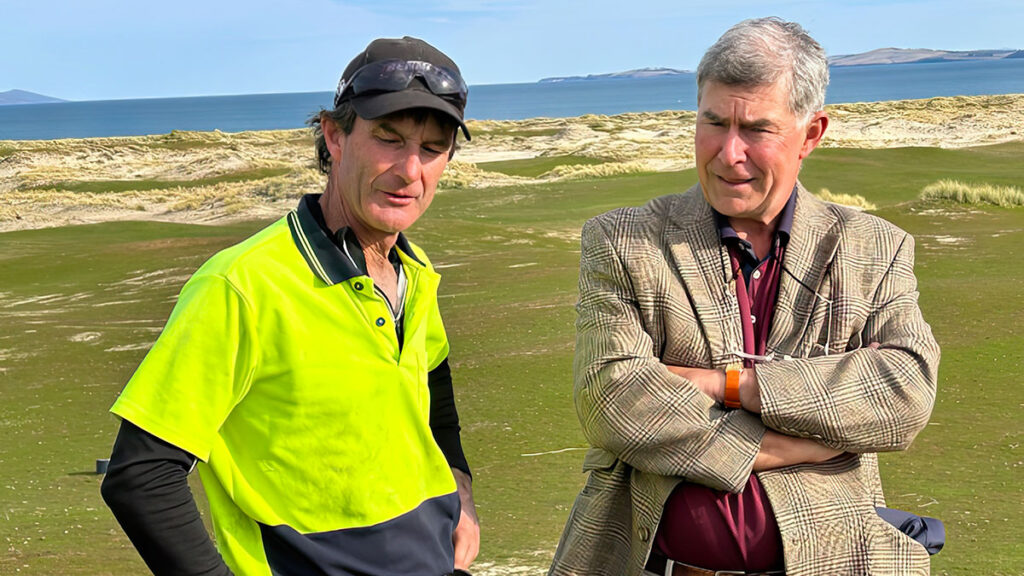Australia’s coastline offers ample space for many more great links courses.
Few Australian golfers have teed up their ball in the Kingdom of Saudi Arabia, though that tiny cohort does include your columnist (and the Australian LIV Golf players). I had a solid round on a fairly ordinary links in Riyadh – the greens actually grassed and irrigated with desalinated water – but thereafter gave up the game in that country for want of a cold beer after the golf. Later I tried to play in Tehran, having made an appointment to meet the chairman of the Iranian Golf Association (he pulled out a day before our match, perhaps out of fear of retribution from the ayatollahs rather than fear of my short game).
In northern Iraq, I was strongly counselled against wandering out with my clubs onto the plains outside Erbil because there were snipers in the nearby hills, and Turkmenistan was, sadly, not a place where God intended golf to be played. Or at least not yet.
The words above illustrate a fact of post-Victorian life: golfers will go to great lengths to hit a ball even in the most far-flung places on the planet, such is the attraction or the compulsion of our beloved game.
A century or more ago, for many people in Britain the name Tasmania conjured up painful thoughts of a penal colony: Port Arthur. Yet today Tasmania is, for golfers across the world, steadily becoming a destination of strong allure. On the northern coast facing Bass Strait lie the two wonderful courses at Barnbougle, and literally in Bass Strait on King Island there is to be found more heavenly links golf.
But the best of all is probably a year away from opening – the course at Seven Mile Beach close to Hobart Airport. On a sunny day in September, I found my way there to inspect the course and to enjoy a special moment of a personal nature.

1954 was a remarkable year for Australian golf. My father won his first Open Championship at Royal Birkdale, Doug Bachli won the British Amateur at Muirfield, and – what is too often overlooked – Peter Toogood from Tasmania won the silver medal at The Open. Who did I meet at Seven Mile Beach to walk around the course? Anthony Toogood, Peter’s son. An experienced course superintendent, Anthony supervised the construction of this beautiful links and is currently finishing the grassing of the final four holes. It was quite a moment when both of us stood on a knoll where the 15th tee is built reflecting on what our fathers had achieved so long ago.
Seven Mile Beach will doubtless become a must-play course, and I can easily foresee the day when it will be difficult to get a tee-time there. The holes themselves look magnificent, as is the view over the deep blue surface of Tiger Head Bay. Tasmania – and the city of Hobart – as a holiday destination is possibly the biggest travel secret in the English-speaking world. With the northern hemisphere steadily sinking into geopolitical disaster, the future for Tasmania is conversely very bright. Golf at Seven Mile Beach will add to that lustre.
The heroic effort of Mat Goggin, Mike Clayton, Anthony Toogood and their other colleagues to build the course at Seven Mile Beach does, however, illustrate something rather peculiar elsewhere – the abundance of excellent sandy land along the coast of Victoria and New South Wales and the shameful lack of great seaside golf courses. Victoria is probably the chief culprit in this regard. Even with the wonderful 13th Beach courses near Barwon Heads – host to the Victorian Open – and Port Fairy’s glorious links, both the eastern coast in Gippsland the western coast from Warrnambool to Cape Bridgewater have immense of strips of beachside public land covered with weedy ti-tree that’s never visited except by seagulls. At least a half dozen versions of Seven Mile Beach or Barnbougle ought to be built there for the benefit of Australian and overseas-visiting golfers. NSW could easily equal that if the authorities would see sense.
Public golf courses in regional Australia perform a crucial role – they attract people to live nearby by generating work. Australia’s cities are all experiencing a shortage of housing, especially rental housing. Trying to hurry the construction of additional dwellings in a business and tax environment that actually penalises such investment is fruitless (not that such a contradiction has been an impediment to foolish policy). Like it or not, immigration to this country will continue at high levels, so moving from the cities to the regions is the only practical solution. What do the regions need to attract and employ people? New projects. Golf courses and hotels are a no-brainer.
Victoria is groaning under the weight of a huge public debt. It has few assets to sell to pay down the principal, but coastal land is one of those assets, and selling some of it for golf development is a win-win solution: you get more regional jobs, and you make it easier to pay for the schools, hospitals and police that a civilised society requires. NSW, though less indebted, is essentially in the same basket.
How many state treasury officials play golf? I reckon it ought to be compulsory. Put away the calculator and pick up your putter, I say.



